its paid sponsors, whose products you need!
“Stay ‘unreasonable.’ If you don’t like the solutions
[available to you], come up with your own.”
Dan Webre
The Martialist does not constitute legal advice.
It is for ENTERTAINMENT PURPOSES ONLY.
Copyright © 2003-2004 Phil Elmore, all rights reserved.
Meyerco A-OK Executive and Tactical
A Product Review by Phil Elmore
 The
The
first assisted-opening knives of which I am aware came from
Meyerco, whose
Blackie Collins designs feature generous handles and sweeping curves.
Among cutlery consumers the Meyerco Speedster is well known. I’m also quite
fond of the company’s folding razor utility knife built on the same frame.
In addition to these models, Meyerco now offers a new line called the A-OK
(Assisted Opening Knife), which consists of “executive” and “tactical”
siblings.
If these knives are twins, they are fraternal rather than
identical. The A-OK executive model is a slim utility blade that comes
with a Nylon sheath and is packaged in a small cardboard box. The A-OK
tactical model is a chunky fistful, by contrast, shipped in a brick-sized
plastic presentation box. The A-OK tactical measures 7.5 inches with a
3.25 inch blade, while the executive (or “personal”) model is a little more
than 6 inches overall with a 2.75 inch blade. Both blades are 440C
stainless.
The personal A-OK has G10 scales. The much bulkier
tactical knife has a synthetic handle. Both are open-frame designs.
the tactical version has a very large, very prominent pocket clip, while the
personal A-OK’s hook-and-loop-closure sheath can ride vertically or
horizontally.
Personal A-OK
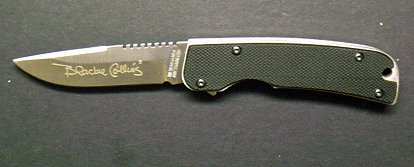
The executive version of Meyerco’s A-OK.
The Chinese-made executive A-OK looks, at first glance, like
a gent’s pocket folder. Lettering on the blade clearly states that it
should be carried in its factory sheath, however. This is probably
because there is no means of keeping the blade from springing open inside a
pocket.
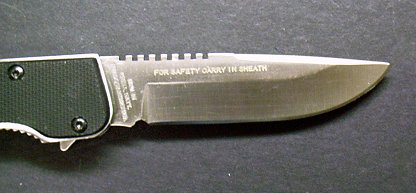
There is no doubt that the knife is intended for
sheath carry.
I prefer horizontal carry for belt sheaths, so I was pleased
with the A-OK’s ballistic Nylon model. Of relatively light fabric with
adequate workmanship, the sheath has small horizontal loops that just fit my
standard belt. The vertical loop is much longer, as is often the case
with this type of sheath.
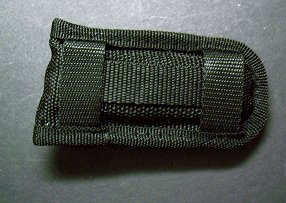
The rear of the personal A-OK sheath.
Wearing the sheath above and forward of my strong-side
pocket, I found I could easily pull the closure before sliding the knife out
and opening it with one hand.
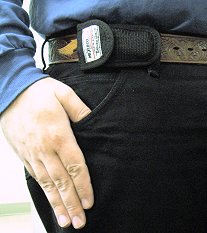
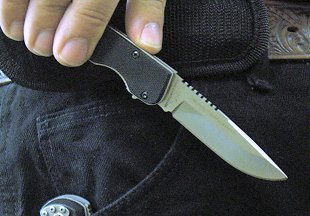
Fit and finish of the knife are pardon the pun okay for
an inexpensive folder and slightly above average for a Chinese import.
There is a lined lanyard hole in the butt. The G10 scales feel pleasant
and provide adequate traction, while the serrations cut into the spine of the
blade are precise and deep.
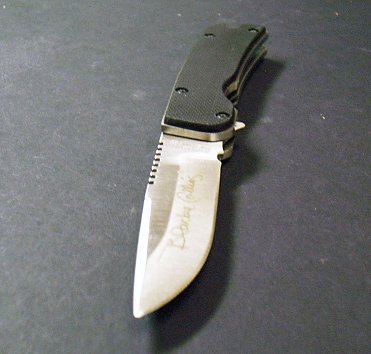
The A-OK is opened using a small nub that protrudes from the
blade. It is similar to the Carson Flipper found on the
CRKT M16, but too small to
form a true integral guard. A firm swipe of the index finger causes the
blade to arc out and lock open. The spring on my sample puts the blade
in place fairly quickly when pointed down (and thus assisted by gravity).
It is less energetic when the knife is held parallel to the ground and will
not open completely if the knife is held vertically. Those carrying this
knife on a daily basis can ensure positive opening by adding a wrist flick to
the finger-swipe.
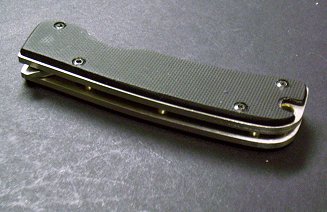
The liner lock on my personal A-OK engages the blade tang
fully and completely to the right. There is moderate blade play, both
horizontal and vertical. Releasing the liner is easy, though the
spring-assist resists closure and makes one-handed closing slightly more
difficult than it would be on a completely manual knife.
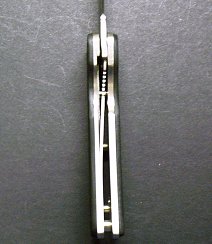
Personal A-OK liner lock engaged.
The blade is well suited to utility tasks. My sample
was not very sharp out of the box, though it is ground on both sides. I
touched it up with a pocket diamond hone and used it to open mail and cut up a
few cardboard boxes, after which it needed sharpening again. The knife
was easy to hone and performed as you would expect from a 440 series blade.
Tactical A-OK
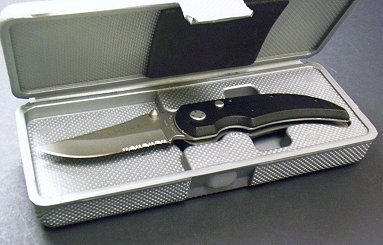
Meyerco’s tactical version of the A-OK.
My first impression of the tactical A-OK revolved around its
thickness. This is a handful of knife, about eleven sixteenths of
an inch thick through the synthetic handle halves. The
pocket clip rises from the handle another
quarter of an inch before bending down and out into a wide spoon with a hole
in the tip. The clip had good tension on the pocket of my jeans.
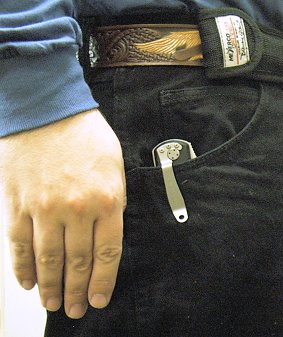
The A-OK tactical, like its smaller sibling, is spring
assisted. Pushing the blade open with the graduated, ambidextrous thumb
studs causes it to spring open the rest of the way. A firm wipe of the
thumb sends the blade arcing open at a moderate pace, the internal mechanism
making a brief and vaguely ratchet-like sound.
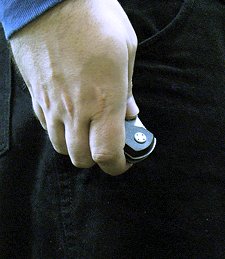
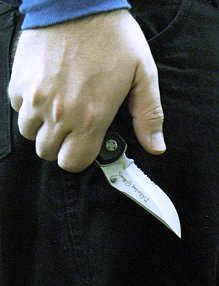
The knife is a liner lock like its little brother. A
button has been added to the mechanism, which means the lock can be released
without endangering one’s fingers. Open, the blade on my sample has
moderate vertical play and some horizontal play as well. The liner
engages fully and in the middle-to-right portion of the tang.
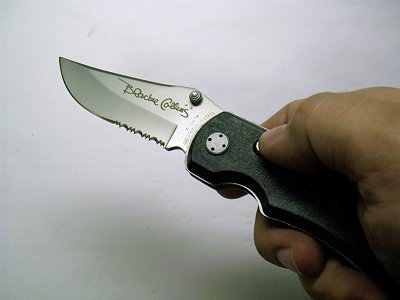
Releasing the tactical model’s button lock, which
pushes the liner.
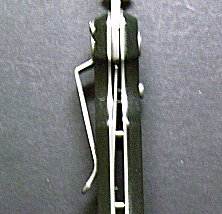
Tactical A-OK liner engaged.
The tactical A-OK’s upswept skinner profile makes it a
natural slashing tool. Fairly sharp out of the box, it was ground on
both sides (except for the serrations) and cut easily through heavy plastic.
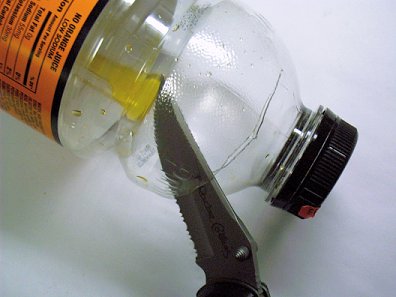
The tactical A-OK cut cleanly through heavy plastic.
The knife fits my thick hands well. As a result,
despite its bulky handle I found that it moved well. My thumb went
naturally to the serrations on the thumb rest, which are good (though I prefer
such grooves to be deeper). The index finger cutout forms a shallow
integral guard.
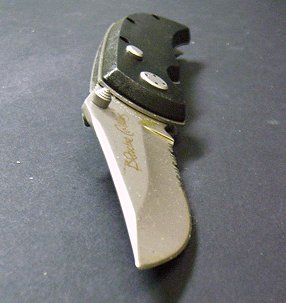
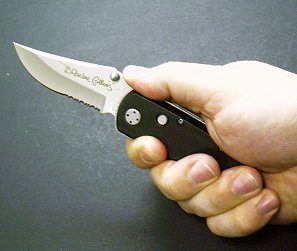
The contours of the handle proved quite ergonomic, at least
for me. The surface of the handle slabs is fairly smooth and therefore a
little slippery. The pocket clip is removable and configured for
right-hand, tip-down carry only.
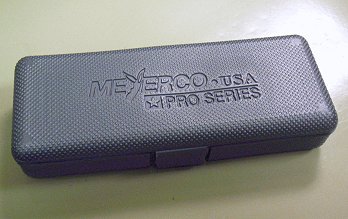
The tactical A-OK was shipped in this plastic brick.
A-OK Prices
As Chinese imports, these Meyerco knives are relatively
low-cost blades. That is their strongest selling point in a market
saturated with other knives of roughly the same type. The personal and
tactical A-OK blades fulfill needs most knife users have and they do so
economically.
That’s A-okay by my wallet.
